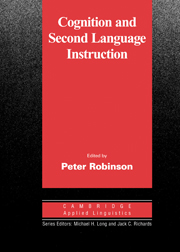Book contents
- Frontmatter
- Contents
- Series editors' preface
- Preface
- SECTION I THEORETICAL ISSUES
- 1 Attention
- 2 Memory for language
- 3 The competition model: the input, the context, and the brain
- 4 Sentence processing
- 5 Automaticity and automatization
- 6 Learnability and second language acquisition theory
- SECTION II COGNITION AND INSTRUCTION
- References
- Index
6 - Learnability and second language acquisition theory
Published online by Cambridge University Press: 05 October 2012
- Frontmatter
- Contents
- Series editors' preface
- Preface
- SECTION I THEORETICAL ISSUES
- 1 Attention
- 2 Memory for language
- 3 The competition model: the input, the context, and the brain
- 4 Sentence processing
- 5 Automaticity and automatization
- 6 Learnability and second language acquisition theory
- SECTION II COGNITION AND INSTRUCTION
- References
- Index
Summary
Introduction: SLA theory
The fundamental goal of a theory of second language acquisition (SLA) is to explain the acquisition of competence in a second language. This may seem a straightforward enough formulation, but it includes some not-so-innocent presuppositions that should be made explicit. Especially we need to be careful with the terms ‘explain’, ‘acquisition’, and ‘competence’.
I am assuming that a theory, any theory, has as its aim the explanation of some phenomena within its domain; not mere description, and not just prediction (Gregg, 1993). Of course, a sufficiently precise description of the phenomena is a requisite for a satisfying explanation, and successful predictions are useful evidence that the explanation is in fact correct. But the goal is explanation. I belabour this point because in fact it is anything but easy to agree on whether an explanation has been offered, let alone a successful one. I return to this question in the next section.
In our case the phenomenon in question is linguistic competence – that is to say, knowledge of a language. This means that our domain is centrally and inevitably mental; while we are necessarily interested in the behaviour of L2 learners on the one hand, and in the characteristics of individual languages on the other, what the SLA theorist in fact wants to explain is not why L2 learners say such-and-such, or why certain languages have such-and-such a construction, but rather why learners have the knowledge they do have of an L2, and of course how they come to have it.
- Type
- Chapter
- Information
- Cognition and Second Language Instruction , pp. 152 - 180Publisher: Cambridge University PressPrint publication year: 2001
- 15
- Cited by

